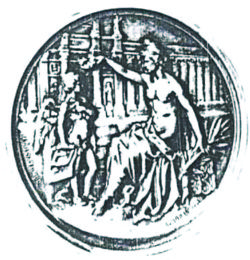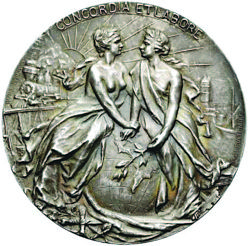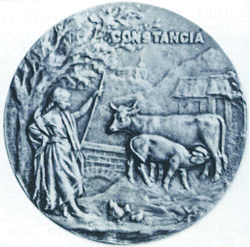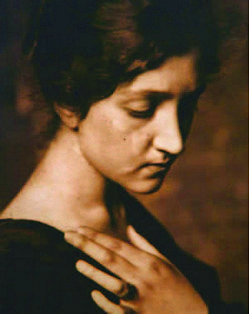The Face of an Angel
by Kim Rud
El Ángel de la Independencia on Mexico City’s Paseo de la Reforma boulevard has leant her considerable beauty to Mexican medals, banknotes, and coins; most notably the 50 peso Centenario and gold and silver bullion series. The importance of this graceful numismatic icon merits an examination of the sculpture’s rich history and legend.
To Antonio Rivas Mercado´s distress everyone called the statue that crowned his Column of the Centenary of Independence an angel. He intended to depict Liberty, the Roman goddess of freedom. Others called it Winged Victory, or Nike, the Greek goddess of triumph. While the sculpture has Nike’s wings and lacks a pileusThe pileus was a hat worn by emancipated Roman slaves. The so-called Phrygian slave cap is an 18th century contrivance., or Liberty cap on her head or lifted on a festucaThe festuca was a rod placed on a slave’s head during the ceremony in which the slave was freed. It is mistakenly referred to in coin literature as a scepter or spear., she does hold three chain links to represent freedom from three centuries of Spanish bondage. The result is an elegant mestizaje of Greek and Roman culture. As one of the most renowned Mexican architects of the time, Mercado Rivas (1853-1927) participated in President Porfirio Díaz’s ambitious plans to modernize Mexico in the years leading up to the celebration of Mexico’s first century of independence in 1910. This is not to say that Mexican architects had the most prominent role in the enterprise. Diaz assumed that to replicate Europe one had to hire Europeans so they received the most substantial projects. When Rivas Mercado’s two designs for a new National LegislatureEl Edificio de Poder Legislativo in Mexico City was never completed but its cupola became El Monumento a la Revolución Mexicana, featured on the 1985 200 and 500 peso coins were rejected in favor of a French design, he was extended an olive branch in 1900 by being named project director of the Column of the Centenary of Independence.
The sculptor of el Ángel was Enrique Alciati. Born in Marseilles, he arrived in Mexico about 1889. His sculptures of national heroes and symbolic effigies beautify Mexico City, and his statue of Benito Juárez in Washington DC was a gift from Mexico. He won prizes at the 1893 Chicago and 1895 Atlanta Expositions. He also designed medals. On Alciati’s 1898 Certamen de Arquitectura medal in Frank Grove’s Medals of Mexico, Vol. II (Gr 333) a Liberty cap identifies the female figure.
 Grove 333
Grove 333
As is characteristic, the gender of Liberty is explicit but that of the angel is not. The Liberty cap is ubiquitous to the circulating coinage of both independent Mexico and the USA. In the USA it is always paired with Liberty, while in Mexico this is seldom the case, and never on a denomination larger than a ¼ real. Aside from the few medals of the ambiguous Ángel de la Independencia , this medal might be the only specific depiction of Liberty, though a hundred medals present allegorical female figures, Minervas, Dianas, etc.. Grove calls the figure in Gr E-365 Liberty but she appears to be a warrior. The left façade of the building resembles Rivas Mercado’s Juárez Theater and might be his design for the National Legislature. Remarkably the angel wears a Liberty cap.
 Grove 347
Grove 347
The two female figures on the 1901 Segunda Conferencia Pan-Americana medal (Gr-347) represent the Iberian-American and Anglo-American cultures. At the time, statues were being erected in naked splendor in Mexico but in the puritanical USA they were robed from head to toe, so one can speculate as to which figure represents which culture. The robed female points at Mexico on the globe and is restrained by her medallic partner. Both Gr-333 and Gr-347 were engraved by E. Moral, minted in silver and bronze, and had a diameter of 60mm.


Grove E 157
The 1902 Coyoacán, 9° Concurso de Ganadería medal (Gr-157) describes idyllic pastoral scenes. Grove suggests that this medal may have been issued annually until 1909. E. Moral is again the engraver, the metal is bronze, and the diameter is 59mm.
The popularity of el Ángel is highlighted by the fact that the various women ascribed to as the model for the sculpture represent the full spectrum of Mexican Society. The most interesting is the architect Rivas Mercado’s daughter Antonieta. Her biographical novel In the Shadow of the AngelBlair, Kathryn Skidmore, A la Sombra del Ángel, México, 1995 by Kathryn S. Blair, wife of Antonieta’s son Donald, relates that her older sister, Alicia, posed for one of the Column’s bronze medallions, but makes no mention of Antonieta’s face being the model for el Ángel. Moreover, Antonieta was about eight years old when the statue was sculpted. Regardless, the importance of Antonieta Rivas Mercado to Mexican culture and her connection to el Ángel makes the sculpture both a symbol of national independence and women’s rights. The writer Olga Fernández Alejandre epitomizes Antonieta’s proponents: “I would like to side with María Antonieta [as the model] because for me she was a unique representation of womankind, ahead of her time, and for whom we have not given the place she deserves in this, our Mexico”Fernández Alejandre, Olga, “Antonieta, la cara del ángel…su tragedia”, El Diario de Xalapa, 24 August 2011 and correspondence with Kim Rud, 31 August 2011.
 Born in Mexico City in 1900, educated in Mexico and Europe, she had exceptional talent for dance and music, a keen intellect, and became her father’s favorite. In 1913 her mother left her husband for Europe with Alicia making young Antonieta the female head of the household. During the Revolution the family endured terror and deprivation as the Constitucionalistas and Convencionistas repeatedly contested Mexico City. In 1918 Antonieta married Albert Blair, a friend and classmate of Francisco I. Madero’s younger brother Raúl at the Houghton School of Mines in Michigan. Blair joined the Madero Revolution and rose to the rank of captain. Marital differences surfaced as Albert was drawn to business and Christian Science, and Antonieta was attracted to the circle of Diego Rivera, who had been sent to study in Europe by Antonieta’s father, then director of the Academia de San Carlos. After a few years the couple separated and divorced. Upon the death of her father Antonieta inherited a considerable fortune which she used to promote culture in Mexico. She joined a group known as Los Contemporanios and wrote for and edited a magazine of the same name. She co-founded El Teatro Ulíses where the latest dramas were presented, at times in her translations. Her 1928 article “The Mexican Woman” in El Sol de Madrid has been called the most important work on Mexican feminism to date. Letters she wrote during a platonic affair with a Mexican painter were published as Cartas a Manuel Rodríguez LozanoRivas Mercado, Antonieta, Cartas a Manuel Rodríguez Lozano (1927.1930), SEP, 1975. She also formed a group of patrons, including US Ambassador Morrow, to create the National Symphony Orchestra of Mexico with Carlos Chávez as director. When she met the charismatic former Education Secretary José Vasconcelos her interest turned to the social resurrection of post-revolutionary Mexico. As a presidential candidate in 1929 Vasconcelos advocated women’s suffrage. Antonieta joined the campaign, chronicled events, and eventually engaged in a passionate love affair with Vasconcelos. According to Antonieta the persecution of Catholics by the government made wealthy Mexicans loath to financially back the government so loans came from US banks. She wrote bitterly that the government was ”a dictatorship impudently sold out to Wall Street”. Her drama of the inquest and trial of León Toral, assassin of President-elect Álvaro Obregón, expressed sympathy with Toral’s religious motives and referred to Gen. Obregón throughout as gen. Olerón (Big Stink). Vasconcelos’ supporters were killed, beaten, jailed and the election ended in a tainted victory for the ruling party . Antonieta and Vasconcelos went into exile in the USA where she suffered a nervous breakdown and was hospitalized. She had lost custody of her son and unable to bear the separation returned to Mexico, in effect, to kidnap him and join Vasconcelos in France. Now a fugitive with her bank account frozen, with the knowledge that her lover would not leave his wife, and above all, anguished that her child would inevitably be returned to a father indifferent to culture, Antonieta settled on a final, desperate act. The morning of 11 February 1931 she entered Notre Dame de Paris Cathedral, sat in a pew, pointed Vasconcelos’ pistol at her heart, and pulled the trigger. Her life ended in a former place of Liberties. During the French Revolution statues of Liberty had replaced the Cathedral’s statues of the Holy Virgin.
Born in Mexico City in 1900, educated in Mexico and Europe, she had exceptional talent for dance and music, a keen intellect, and became her father’s favorite. In 1913 her mother left her husband for Europe with Alicia making young Antonieta the female head of the household. During the Revolution the family endured terror and deprivation as the Constitucionalistas and Convencionistas repeatedly contested Mexico City. In 1918 Antonieta married Albert Blair, a friend and classmate of Francisco I. Madero’s younger brother Raúl at the Houghton School of Mines in Michigan. Blair joined the Madero Revolution and rose to the rank of captain. Marital differences surfaced as Albert was drawn to business and Christian Science, and Antonieta was attracted to the circle of Diego Rivera, who had been sent to study in Europe by Antonieta’s father, then director of the Academia de San Carlos. After a few years the couple separated and divorced. Upon the death of her father Antonieta inherited a considerable fortune which she used to promote culture in Mexico. She joined a group known as Los Contemporanios and wrote for and edited a magazine of the same name. She co-founded El Teatro Ulíses where the latest dramas were presented, at times in her translations. Her 1928 article “The Mexican Woman” in El Sol de Madrid has been called the most important work on Mexican feminism to date. Letters she wrote during a platonic affair with a Mexican painter were published as Cartas a Manuel Rodríguez LozanoRivas Mercado, Antonieta, Cartas a Manuel Rodríguez Lozano (1927.1930), SEP, 1975. She also formed a group of patrons, including US Ambassador Morrow, to create the National Symphony Orchestra of Mexico with Carlos Chávez as director. When she met the charismatic former Education Secretary José Vasconcelos her interest turned to the social resurrection of post-revolutionary Mexico. As a presidential candidate in 1929 Vasconcelos advocated women’s suffrage. Antonieta joined the campaign, chronicled events, and eventually engaged in a passionate love affair with Vasconcelos. According to Antonieta the persecution of Catholics by the government made wealthy Mexicans loath to financially back the government so loans came from US banks. She wrote bitterly that the government was ”a dictatorship impudently sold out to Wall Street”. Her drama of the inquest and trial of León Toral, assassin of President-elect Álvaro Obregón, expressed sympathy with Toral’s religious motives and referred to Gen. Obregón throughout as gen. Olerón (Big Stink). Vasconcelos’ supporters were killed, beaten, jailed and the election ended in a tainted victory for the ruling party . Antonieta and Vasconcelos went into exile in the USA where she suffered a nervous breakdown and was hospitalized. She had lost custody of her son and unable to bear the separation returned to Mexico, in effect, to kidnap him and join Vasconcelos in France. Now a fugitive with her bank account frozen, with the knowledge that her lover would not leave his wife, and above all, anguished that her child would inevitably be returned to a father indifferent to culture, Antonieta settled on a final, desperate act. The morning of 11 February 1931 she entered Notre Dame de Paris Cathedral, sat in a pew, pointed Vasconcelos’ pistol at her heart, and pulled the trigger. Her life ended in a former place of Liberties. During the French Revolution statues of Liberty had replaced the Cathedral’s statues of the Holy Virgin.

